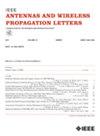5G N78波段波束宽度增强宽带双极化磁电偶极子天线
IF 4.8
2区 计算机科学
Q2 ENGINEERING, ELECTRICAL & ELECTRONIC
引用次数: 0
摘要
本文提出了一种用于5G N78频段的波束宽度增强宽带双极化磁电偶极子天线。与传统的磁电偶极子天线相比,该天线结构新颖。它由底部折叠开槽的磁电偶极子,中间折叠开槽的电偶极子,几个金属柱,顶部四个寄生片,两个Γ-shaped馈电结构和一个地面组成。同时,通过折叠电偶极子和加载金属柱提高了天线的阻抗带宽,通过加载附加电偶极子和开槽磁偶极子分别提高了波束宽度和端口隔离度。顶部放置了四个寄生贴片,以改善天线的阻抗匹配。经测量,两个端口的相对重叠带宽为36.5% (2.87 GHz ~ 4.15 GHz)。当端口1被激发时,e平面和h平面的最大波束宽度分别为211°和126°。当端口2被激发时,e平面和h平面的最大波束宽度分别为208°和127°。因此,该天线在5G基站中具有广阔的应用前景。本文章由计算机程序翻译,如有差异,请以英文原文为准。
Beamwidth Enhanced Broadband Dual-Polarized Magnetoelectric Dipole Antenna for 5G N78 Band
A beamwidth-enhanced broadband dual-polarized magnetoelectric dipole antenna for 5G N78 band is proposed in this letter. The structure of the proposed antenna is novel compared with conventional magnetoelectric dipole antennas. It is composed of folded and slotted magnetoelectric dipoles at the bottom, folded and slotted electric dipoles in the middle, several metal columns, four parasitic patches on the top, two Γ-shaped feeding structures and a ground. Meanwhile, the impedance bandwidth of the antenna is improved by folding the electric dipoles and loading the metal columns, while the beamwidth and port isolation are enhanced by loading additional electric dipoles and slotting the magnetic dipoles, respectively. Four parasitic patches are placed at the top to improve impedance matching of the antenna. By measurement, the overlapped relative bandwidth of two ports is 36.5% (2.87 GHz to 4.15 GHz). When port 1 is excited, the maximum beamwidths in E-plane and H-plane are 211° and 126°, respectively. When port 2 is excited, the maximum beamwidths in E-plane and H-plane are 208° and 127°, respectively. Therefore, the antenna has a wide application prospect in the 5G base station.
求助全文
通过发布文献求助,成功后即可免费获取论文全文。
去求助
来源期刊
CiteScore
8.00
自引率
9.50%
发文量
529
审稿时长
1.0 months
期刊介绍:
IEEE Antennas and Wireless Propagation Letters (AWP Letters) is devoted to the rapid electronic publication of short manuscripts in the technical areas of Antennas and Wireless Propagation. These are areas of competence for the IEEE Antennas and Propagation Society (AP-S). AWPL aims to be one of the "fastest" journals among IEEE publications. This means that for papers that are eventually accepted, it is intended that an author may expect his or her paper to appear in IEEE Xplore, on average, around two months after submission.

 求助内容:
求助内容: 应助结果提醒方式:
应助结果提醒方式:


